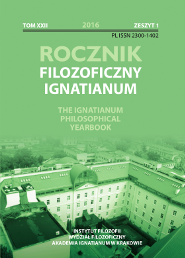Psychological correlates of inner emptiness: a case study
Abstract
Professor Zenomena Płużek has been acknowledged as one of the pioneers and leading scholars in Poland in both the psychology of religion and pastoral psychology. Referring to her research in the area of psychological and psychospiritual crises, this article addresses the issue of the emptiness experienced during psychotherapy as a “dark night”. The case of one particular patient/client will be analyzed from both psychological and religious (theological) perspectives, with the aim of answering the following questions: What do such “dark nights” look like in a clinical context? How should (or can) they be conceptualized in clinical terms? How ought they to be dealt with?References
Blasco-Fontecilla H, León-Martínez de V, Delgado-Gomez D, Giner L, Guillaume S and Courtet P (2013), "Emptiness and Suicidal behavior: An Exploratory Review" (4), pp. 21-32.
Blass RB (2012), "Sin and Transcendence Versus Psychopathology and Emotional Well-Being: On the Catholic Church’s Problem of Bridging Religious and Therapeutic Views of the Person" (12), pp. 21-42.
Chodkiewicz J and Miniszewska J (2014), "Ból psychiczny a występowanie myśli i tendencji samobójczych" (14(1)), pp. 37-42.
Epstein M (2007), "Psychotherapy without the self: A Buddhist perspective" Yale University Press.
Federn P (1952), "Ego Psychology and the Psychoses" Basic Books.
Frankl VE (1976), "Homo patiens" Instytut Wydawniczy PAX.
Giovacchini PL (1972), "The Blank Self", In Tactics and Techniques in Psychoanalytic Therapy. , pp. 364-382. Science House.
Guntrip H (1971), "Schizoid Phenomena, Object Relations, and the Self" Basic Books.
Hanly C (1984), "Ego Ideal and Ideal Ego" (65), pp. 253-261.
Hazell C (2003), "The Experience of Emptiness" 1st Books Library.
Levy ST (1984), "Psychoanalytic Perspectives on Emptiness" (32(2)), pp. 387-404.
May GG (2012), "Ciemna noc duszy. Depresja a kryzys duchowy oczami psychiatry" Wydawnictwo WAM.
Peteet JR (2011), "Approaching Emptiness: Subjective, Objective and Existencial Dimensions" (50(3)), pp. 558-563.
Płużek Z (1991), "Psychologia pastoralna" Instytut Teologiczny Księży Misjonarzy.
Rallis BA, Deming CA, Glenn JJ and Nock MK (2012), "What is the Role of Dissociation and Emptiness in the Occurrence of Nonsuicidal Self-Injury?" (26(4)), pp. 287-298.
Singer M (1977), "The Experience of Emptiness in Narcissistic and Borderline States: I. Deficiency and Ego Defects Versus Dynamic-Defensive Models" (4), pp. 459-469.
Singer M (1977), "The Experience of Emptiness in Narcissistic and Borderline States: II. The Struggle for a Sense of Self and the Potential for Suicide" (4), pp. 471-479.
Wikström O (1998), "Depression and the Absence of God: Religious Studies and/or Theology in Clinical Research" (52(2)), pp. 130-146.
Winnicott DW (1974), "Fear of Breakdown" (1), pp. 103-107.
(2014), "Przeciw melancholii: W 40. rocznicę wydania „Melancholii” Antoniego Kępińskiego - perspektywa fides i ratio" Polska Akademia Umiejętności, Międzynarodowe Towarzystwo Naukowe Fides et Ratio, Accademia Dei Rampanti.
The Yearbook only accepts materials for publication that are free of all conflicts of interest, and that in no way involve conflicts over authorship, copyright, etc. The Editors will take action against any cases of plagiarizing, ghostwriting1, guest/honorary authorship2, etc. Where co-authored work is concerned, the Author listed first is expected to take responsibility for the submission, and is required to make clear the contributions of all of the Co-Authors involved. In the event of the publication owing its existence to funding dedicated to this purpose, this fact should be made clear: e.g. in any note of thanks/acknowledgement, or in a footnote, etc. Explicit notification should be given of any form of reprinting, with the appropriate evidence of permission to publish being furnished as required. Any impropriety on the part of Authors/Reviewers risks exposing them to appropriate responses from the relevant institutions.
______
1 This term refers to instances of a person who has made an essential contribution being omitted from the list of authors, or from notes conveying gratitude and/or acknowledgement.
2 This occurs when a person who has made either an insignificant contribution or no contribution at all nevertheless appears on the list of authors.





